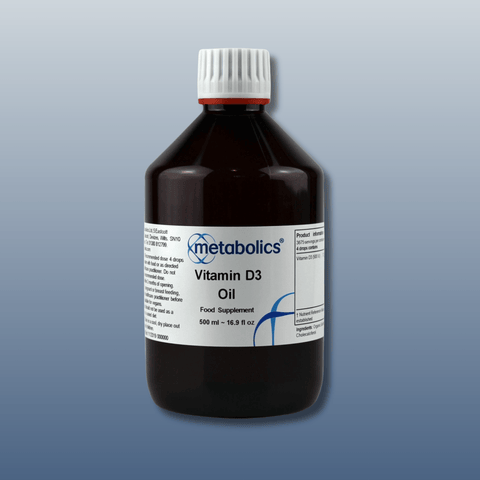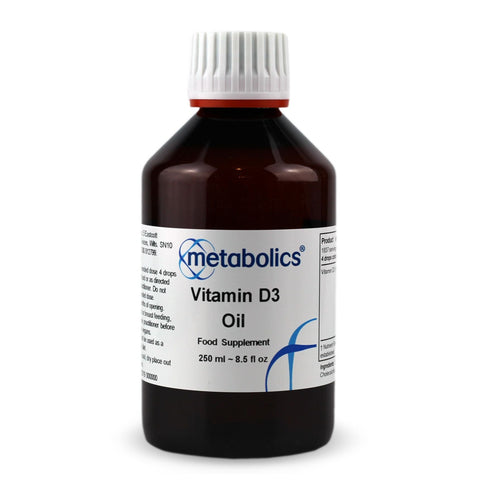Suitable For
What Is Metabolics Vitamin D3 oil?
Metabolics Vitamin D3 Oil is an effective and easily absorbed form of vitamin D, formulated with avocado oil to support optimal absorption and bioavailability.
Vitamin D3, technically a prohormone, is activated in the body to regulate a wide range of biological processes. A key role is enhancing the absorption of calcium and phosphorus—essential minerals for maintaining strong, healthy bones and teeth. It also binds to receptors in most cells, influencing the expression of over 2,000 genes.
While vitamin D3 is naturally synthesised in the skin through sun exposure, several factors—such as limited sunlight, ageing, sunscreen use, and darker skin tones—can impair the body’s ability to produce sufficient levels. This is especially relevant in the UK and other northern climates.
Dietary sources of vitamin D are limited. They include oily fish (such as salmon, mackerel, and sardines), egg yolks, liver, and fortified foods like breakfast cereals and plant-based milk alternatives. Yet even with a varied diet, many people fall short—particularly in winter or when sun exposure is restricted.
Given that a significant proportion of the population now spends up to 90% of their time indoors, vitamin D deficiency has become increasingly common. This can contribute to issues such as reduced bone density and, in severe cases, conditions like rickets or osteomalacia.
What Is Metabolics Vitamin D3 oil for?
Vitamin D supports the body’s ability to absorb and utilise calcium, helping to maintain strong bones and teeth and a healthy immune system.
Key Benefits of Vitamin D
✔ Supports Normal Absorption and Utilization of Calcium and Phosphorus
Vitamin D helps the body absorb and utilise calcium and phosphorus—key minerals for healthy bones and teeth. Deficiency can lead to bone deformities such as rickets in children, and bone pain caused by a condition called osteomalacia in adults.
✔ Helps Maintain Normal Blood Calcium Levels
Vitamin D plays a crucial role in maintaining normal blood calcium levels. It aids in the absorption of calcium from the diet and regulates its levels in the bloodstream, ensuring proper functioning of the nervous and muscular systems.
✔ Contributes to the Maintenance of Normal Bones and Teeth
Adequate Vitamin D levels are essential for bone mineralisation and remodelling. They help ensure proper deposition of calcium and phosphorus in the bone matrix, supporting skeletal strength and helping reduce the risk of fractures.
✔ Supports the Normal Function of the Immune System
Vitamin D plays a key role in regulating immune cells, including T cells and B cells, which identify and target harmful pathogens and abnormal cells. It also supports the differentiation of monocytes and macrophages—immune cells responsible for engulfing and eliminating pathogens. By ensuring these cells develop and function properly, Vitamin D helps maintain a robust immune response. Additionally, it contributes to the innate immune system, the body’s first line of defence, by activating immune cells to respond quickly to infections.
✔ Plays a Role in the Process of Cell Division
Vitamin D is involved in cellular proliferation and differentiation processes, influencing gene expression related to cell cycle regulation.
Why use Metabolics Vitamin D3 oil?
Despite being synthesised through sun exposure, Vitamin D deficiency is now widespread. Several factors can influence the body's ability to produce Vitamin D:
Latitude: People living further from the equator—above 35° latitude—receive less UVB exposure, especially in winter, making it difficult to produce enough vitamin D from sunlight between November and March.
Season: UVB radiation varies with seasons; production is higher in summer months.
Altitude: Higher altitudes receive more UVB exposure due to thinner atmosphere, increasing the body’s ability to produce vitamin D compared to lower elevations.
Time of Day: UVB exposure peaks when the sun is directly overhead, typically between 10 AM and 3 PM.
Air Pollution and Cloud Cover: Both can reduce UVB penetration, decreasing Vitamin D production.
Sun Protection: While essential for skin health, high SPF sunscreens can block UVB rays almost entirely, preventing vitamin D synthesis.
Skin Pigmentation: Individuals with darker skin have more melanin, which can reduce the skin's ability to produce Vitamin D.
Age: As we age, the skin produces less vitamin D. A 70-year-old may generate up to 75% less than a 20-year-old with the same sun exposure—compounded by spending less time outdoors and wearing more covering clothing
Body Weight: Higher body fat percentages can sequester more Vitamin D, making it less bioavailable.
Clothing: Cultural or climate-related full-body clothing can block UVB from reaching the skin.
Common Signs of Vitamin D Deficiency
· Bone pain and muscle weakness
· Increased susceptibility to infections
· Fatigue and general tiredness
· Mood changes, including low mood or depression
· Impaired wound healing
Severe deficiency can result in rickets (children) or osteomalacia (adults).
NHS Recommendations (UK)
According to the NHS, the recommended daily intake of Vitamin D₃ (cholecalciferol) varies by age and individual circumstances:
· Adults and children over 1 year: 10 micrograms (400 IU) daily
· Infants under 1 year: 8.5 to 10 micrograms (340–400 IU) daily
For more detailed guidance see NHS recommendations.
However, emerging research suggests these levels may be conservative, particularly given the prevalence of deficiency and the increasing understanding of vitamin D's role in immune and long-term health. As a result, some healthcare professionals recommend higher daily intakes, depending on individual needs. For personalised advice, it’s best to consult a healthcare practitioner.
Why Choose Metabolics Vitamin D3 Oil?
Metabolics Vitamins D3 Oil is formulated in a base of nutrient-rich avocado oil to support optimal absorption. Avocado oil is naturally rich in oleic acid (omega-9), a heart-healthy monounsaturated fat similar to that found in olive oil. It supports the effective delivery of fat-soluble vitamins like vitamin D, making it an ideal carrier oil.
🔹 Pure & High-Quality – Free from unnecessary fillers and additives
🔹 Formulated with Avocado Oil – Enhances absorption and bioavailability
🔹 Trusted Brand – Third-party tested and manufactured in the UK
✅ Order Metabolics Vitamin D3 Oil today for daily support of your bones and immune system— all year round.
Note: Note suitable for vegans.
Supplement Facts
4 drop contains
%NRV*
Vitamin D3 (500 IU)
12.5 ug
250%
† Nutrient Reference Value (NRV*) not established
Ingredients
Directions / Dosage
 Oil
Oil
Warning
Storage
Product Type










